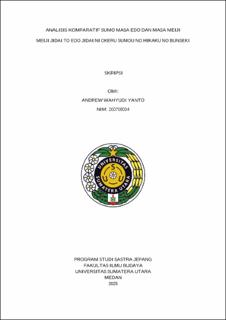Analisis Komparatif Sumo Masa Edo dan Masa Meiji Meiji Jidai To Edo Jidai Ni Okeru Sumou No Hikaku No Bunseki
Comparative Analysis of Sumo in the Edo Period and the Meiji Period Meiji Jidai To Edo Jidai Ni Okeru Sumou No Hikaku No Bunseki

Date
2025-07-28Author
Yanto, Andrew Wahyudi
Advisor(s)
Arfianty, Rani
Alimansyar
Metadata
Show full item recordAbstract
This research aims to analyze the similarities and differences in the development of
SUMO during the Edo period (1603–1868) and the Meiji period (1868–1912).
Theories employed include cultural theory, historiography, social change theory, and
comparative theory. The research method used is descriptive qualitative, with data
collected through observation and note-taking techniques from documentary videos.
The results show that SUMO during the Edo and Meiji periods shared similarities in
terms of the structure of the dohyo (arena), the wrestler ranking system (banzuke), prematch rituals, and the social function of SUMO as entertainment and a cultural symbol.
However, there were significant differences, such as the relocation of matches from
shrine grounds to dedicated arenas, the disappearance of the dohyo’s supporting
pillars, and the transformation of wrestlers' status from reliance on local patronage to
professional athletes under the management of the Nihon SUMO Kyokai. Although
SUMO underwent modernization during the Meiji era, it continued to preserve the
traditional values of Japanese culture.
Collections
- Undergraduate Theses [593]
